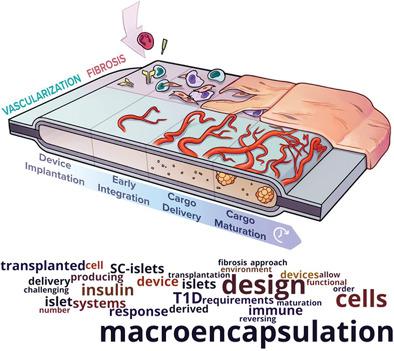Our official English website, www.x-mol.net, welcomes your feedback! (Note: you will need to create a separate account there.)
Design Considerations for Macroencapsulation Devices for Stem Cell Derived Islets for the Treatment of Type 1 Diabetes
Advanced Science ( IF 15.1 ) Pub Date : 2021-06-21 , DOI: 10.1002/advs.202100820 Debkalpa Goswami 1 , Daniel A Domingo-Lopez 2 , Niamh A Ward 3 , Jeffrey R Millman 4, 5 , Garry P Duffy 2, 6, 7 , Eimear B Dolan 3 , Ellen T Roche 1, 8
Advanced Science ( IF 15.1 ) Pub Date : 2021-06-21 , DOI: 10.1002/advs.202100820 Debkalpa Goswami 1 , Daniel A Domingo-Lopez 2 , Niamh A Ward 3 , Jeffrey R Millman 4, 5 , Garry P Duffy 2, 6, 7 , Eimear B Dolan 3 , Ellen T Roche 1, 8
Affiliation

|
Stem cell derived insulin producing cells or islets have shown promise in reversing Type 1 Diabetes (T1D), yet successful transplantation currently necessitates long-term modulation with immunosuppressant drugs. An alternative approach to avoiding this immune response is to utilize an islet macroencapsulation device, where islets are incorporated into a selectively permeable membrane that can protect the transplanted cells from acute host response, whilst enabling delivery of insulin. These macroencapsulation systems have to meet a number of stringent and challenging design criteria in order to achieve the ultimate goal of reversing T1D. In this progress report, the design considerations and functional requirements of macroencapsulation systems are reviewed, specifically for stem-cell derived islets (SC-islets), highlighting distinct design parameters. Additionally, a perspective on the future for macroencapsulation systems is given, and how incorporating continuous sensing and closed-loop feedback can be transformative in advancing toward an autonomous biohybrid artificial pancreas.
中文翻译:

用于治疗 1 型糖尿病的干细胞衍生胰岛大封装装置的设计考虑因素
干细胞衍生的胰岛素产生细胞或胰岛已显示出逆转 1 型糖尿病 (T1D) 的希望,但目前成功的移植需要免疫抑制剂的长期调节。避免这种免疫反应的另一种方法是利用胰岛大封装装置,其中胰岛被整合到选择性渗透膜中,该膜可以保护移植细胞免受急性宿主反应,同时能够输送胰岛素。这些宏观封装系统必须满足许多严格且具有挑战性的设计标准,才能实现逆转 T1D 的最终目标。在这份进展报告中,回顾了大封装系统的设计考虑因素和功能要求,特别是干细胞衍生的胰岛(SC-islet),强调了不同的设计参数。此外,还对宏观封装系统的未来进行了展望,以及如何将连续传感和闭环反馈相结合,以推动自主生物混合人工胰腺的发展。
更新日期:2021-08-19
中文翻译:

用于治疗 1 型糖尿病的干细胞衍生胰岛大封装装置的设计考虑因素
干细胞衍生的胰岛素产生细胞或胰岛已显示出逆转 1 型糖尿病 (T1D) 的希望,但目前成功的移植需要免疫抑制剂的长期调节。避免这种免疫反应的另一种方法是利用胰岛大封装装置,其中胰岛被整合到选择性渗透膜中,该膜可以保护移植细胞免受急性宿主反应,同时能够输送胰岛素。这些宏观封装系统必须满足许多严格且具有挑战性的设计标准,才能实现逆转 T1D 的最终目标。在这份进展报告中,回顾了大封装系统的设计考虑因素和功能要求,特别是干细胞衍生的胰岛(SC-islet),强调了不同的设计参数。此外,还对宏观封装系统的未来进行了展望,以及如何将连续传感和闭环反馈相结合,以推动自主生物混合人工胰腺的发展。


























 京公网安备 11010802027423号
京公网安备 11010802027423号